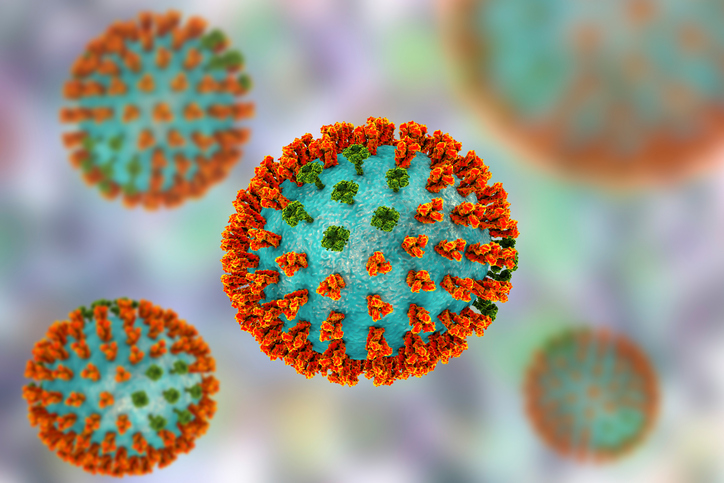- Krammer F, Smith GJ, Fouchier RA, Peiris M, Kedzierska K, Doherty PC, Palese P, Shaw ML, Treanor J, Webster RG, García-Sastre A (28 June 2018). "Influenza". Nature Reviews Disease Primers. 4 (1): 3.
- Sautto GA, Kirchenbaum GA, Ross TM (19 January 2018). "Towards a universal influenza vaccine: different approaches for one goal". Virology Journal. 15 (1): 17.
- Allen JD, Ross TM (2018). "H3N2 influenza viruses in humans: Viral mechanisms, evolution, and evaluation". Human Vaccines & Immunotherapeutics. 14 (8): 1840–1847.
- Lampejo T (July 2020). "Influenza and antiviral resistance: an overview". European Journal of Clinical Microbiology & Infectious Diseases. 39 (7): 1201–1208.
- "Flu Symptoms & Diagnosis". Centers for Disease Control and Prevention (CDC). 10 July 2019.
- "Flu Symptoms & Complications". Centers for Disease Control and Prevention (CDC). 26 February 2019.
- Call SA, Vollenweider MA, Hornung CA, Simel DL, McKinney WP (February 2005). "Does this patient have influenza?". JAMA. 293 (8): 987–97.
- Dharmapalan D (October 2020). "Influenza". Indian Journal of Pediatrics. 87 (10): 828–832.
- Ghebrehewet S, MacPherson P, Ho A (7 December 2016). "Influenza". The BMJ. 355: i6258.
- Sederdahl BK, Williams JV (13 January 2020). "Epidemiology and Clinical Characteristics of Influenza C Virus". Viruses. 12 (1): 89.
- Peteranderl C, Herold S, Schmoldt C (August 2016). "Human Influenza Virus Infections". Seminars in Respiratory and Critical Care Medicine. 37 (4): 487–500.
- Kalil AC, Thomas PG (19 July 2019). "Influenza virus-related critical illness: pathophysiology and epidemiology". Critical Care. 23 (1): 258.
- "Virus Taxonomy: 2019 Release". International Committee on Taxonomy of Viruses. Retrieved 9 March 2021.
- Li YT, Linster M, Mendenhall IH, Su YC, Smith GJ (11 December 2019). "Avian influenza viruses in humans: lessons from past outbreaks". British Medical Bulletin. 132 (1): 81–95.
What is the flu? Why is it caused, what are its manifestations, the course and treatment?

Influenza is a highly infectious disease that mainly affects the respiratory system. It is caused by a virus, which can spread through the air. It is mild, but sometimes it gets really complicated. In the most severe cases, it can even cause death.
Most common symptoms
- Muscle Pain
- Malaise
- Chest pain
- Abdominal Pain
- Headache
- Sore Throat
- Joint Pain
- Limb pain
- Eye Pain
- Painful Breathing
- Ear Pain
- Back Pain
- Sensitivity to light
- Fever
- Spirituality
- Diarrhoea
- Indigestion
- Nausea
- Full nose
- Tremor
- Dry mouth
- Dry cough
- Muscle weakness
- Head spinning
- Tremors
- Fatigue
- Damp cough
- Vomiting
- Coughing up mucus
- Redness of the conjunctivae
- Lingering in the ears
- Winterreise
- Accelerated heart rate
- Enlarged lymph nodes
- Increased body temperature
Characteristics
Influenza is a highly contagious infectious disease of the respiratory system. It is acute and may be mild and uncomplicated or exacerbated by complications.
In the most severe cases, it can cause death.
First time written reference of the influenza epidemic dates from Athens in 412 BC by Hippocrates.
It is caused by viruses of the Orthomyxoviridae family. We recognize three types of viruses, namely A, B and C. These can differ into different subtypes. Their diversity and variety are provided by two glycoproteins, antigens.
The first is the hemagglutinin H and the other neuraminidase N. Based on that, a subtype of influenza is distinguished, which gives them diverse and characteristic features.
Main types of influenza:
- Influenza A virus
- Influenza B virus
- Influenza virus type C
The most common is type A, which affects not only humans but also animals. As it was the case with the avian or swine flu pandemic.
Influenza has the ability to change its antigenic properties, hence its structure. These influenza mutations allow a person not to be immune to the other type after overcoming the initial type. This different and mutated type may vary in the severity and overall course of the disease.
Influenza viruses spread through the air as a drip infection, but also through contaminated objects. In some cases, they live up to 48 hours on them.
They enter our body through the mouth or nose, that is the respiratory system, but also through the conjunctiva. Coughing or sneezing contributes to this.
The severity of the transfer is also due to the very short incubation period .
It is reported that it can take 12 hours to 3 days from infection to the onset of the first symptoms. Acute outbreaks of the disease from complete health are followed by symptoms such as weakness, fatigue, headache, whole body, muscles and joints. But also increased body temperature or cough, sneezing and mucus formation.
The table shows the difference in influenza types
| Type of flu | Description |
| Influenza A virus |
|
| Influenza B virus |
|
| Influenza C virus |
|
The flu is characterized by the fact that it can spread very quickly. It causes global epidemics and pandemics every year. Which means that the disease affects a large population, outside cities, counties or even states.
It affects 5 to 15% of the world's population worldwide and year-round.
The serious course of the disease affects up to 5 million people. It is said that up to 500,000 sick people die from the flu and die from its complications worldwide .
In Slovakia, approximately 1-2 million people become ill from influenza and its similar diseases.
It starts in autumn until the end of winter. Its season is reported to have a peak in January to February.

It affects every age group. The most vulnerable groups are the elderly (over 65), who also have other and long-term health problems. This group is more at risk of complications.
Then there are children, pregnant women, and long-term sick people with oncological diseases, diseases of the respiratory or heart system, but also people with diabetes or weakened immunity.
The most common complications of influenza :
- otitis media
- sinusitis - sinus infection
- pneumonia
- bronchopneumonia complication of streptococcal or staphylococcal superinfection
- primary influenza pneumonia
- inflammation of the heart muscle - myocarditis
- Rey's syndrome - a rare complication, caused by a combination of viral disease and treatment of children with salicylates , such as acylpirine, which is therefore contraindicated during this period, so it is not recommended to use in children with fever and pain, another drug should be taken.
- encephalitis, encephalitis
- dehydration
- in children, febrile convulsions, ie fever convulsions
Read also:
Dehydration and its symptoms; Severity of dehydration in children
Although the flu is called a respiratory disease, it affects the entire body.
Diagnosis of influenza is not complicated and is based primarily on the symptoms of the disease. Its treatment is primarily symptomatic, relieving symptoms. Antivirals are given to a selected group of at-risk people and in a more severe course.
Antibiotic treatment is ineffective .
Antibiotics are intended exclusively for the treatment of bacterial diseases.
They are used only for superinfection with a bacterial infection or as a prevention.
A treatment regimen is also necessary, which includes relaxing and resting. Sufficient length and isolation from other people is important.
Influenza has an annual and global economic impact. As it is the cause of the incapacity for work of adults and also the absence of school attendance among children.
Is it the flu, cold or cold?
The flu is often neglected by the public and people call it an insignificant disease. However, its treatment and prevention is important. It is often confused with colds, rhinitis or other virosis.
How to distinguish the flu from colds or rhinitis - we show in the table
| Flu | Cold | Rhinitis | |
| Body temperature | fever , exceeds 39 ° C body temperature | mostly up to 38 ° C | does not occur |
| Headache | very common and pronounced | sometimes | does not occur |
| A sore throat | sometimes | often | does not occur |
| Muscle and joint pain | very often and significantly | sometimes | does not occur |
| A cough | dry and irritating | mild | mild |
| Sneezing | sometimes | often | often |
| Fatigue and weakness | significant weakness, which persists for up to 2 weeks | mild | mild |
| Complications | inflammation of the middle ear, lungs, heart muscle in the worst cases, a threat to health and life | inflammation of the middle ear and sinuses | otitis media |
| Vaccination prevention | there is a vaccination that is adapted every year | none | none |
| Treatment | symptomatic, depends on the complications | simple and short-lived | simple and short-lived |
How to distinguish the flu from colds or colds? The information from the following articles will also help you in this:
- What all diseases include the term inflamed throat
- Colds in children - not just in summer
- Specifics of influenza in children
- What to look out for during flu during pregnancy
- Basic information about rhinitis
- What is otitis media
Causes
Influenza is caused by medium-sized viruses, influenza viruses, which are approximately 90-120 nm in size. They belong to the family Orthomyxoviridae.

They differ in the three types A, B, and C .
Influenzavirus Type A occurs in humans as well as in animals such as birds - A Avian, pigs - A Swine or horses - A Equi.
Influenzavirus types B and C causes disease only in humans .
In addition, viruses are divided according to the composition and combination of hemagglutinin - H and neuraminidase - N. They are called antigens that are important in the body's immune response. Examples of dangerous types for humans are H1, H2, H3 or N1, and N2.
For example, we know these strains of the flu virus, we list them in the table
| Type | Description |
| Influenza A virus and H3N2 subtype |
|
| Influenza A virus and H1N1 subtype |
|
| Influenza A virus and H3N2 subtype |
|
| Influenza B virus |
|
| Bird flu |
|
| Spanish flu |
|
| Asian flu |
|
| Hong Kong flu |
|
The emergence of several types and subtypes ensures the property of excellent variability.
Type A influenza has the highest variability. There is a change at both the H and N levels. This mutation takes place in two forms.
2 forms of change, referred to as:
- antigenic shift - drift, which results in smaller changes and occurs more frequently
- these minor changes result in annual epidemics or pandemics
- antigenic exchange - shift, which is involved in the emergence of a new subtype
- less often, once every 10 to 40 years
- the shortest interval lasted 9 years
- an example is bird or swine flu
The influenza B virus is more stable in this respect. It causes milder and sporadic (less common) infections and smaller epidemics. It has an easy course.
Type C is unlikely to be altered or not detected and does not contain neuraminidase. Its disability does not cause health-related diseases. The course is mild and often asymptomatic.
Occurrence of influenza
The diversity of influenza is its advantage, which causes diseases to varying degrees every year, in terms of epidemics or less often pandemics. Influenza has a typical seasonal occurrence.
The onset of the flu season, ie the season, is in autumn, approximately from 1 October to spring, approximately 30 April.
It reaches its highest peak in January to the beginning of February.
How does the flu spread?
The transmission of viruses is carried by air, and thus by droplet infection. Coughing or sneezing contributes to this, but also talking or direct contact. Even in favorable conditions for the virus to live for up to 48 hours and on hands, handkerchiefs, or subjects.
The flu virus also survives in the cold. Freezing air dries the mucous membrane of the nose more easily, which reduces its defenses and increases the chance of infection.
The source of the virus is a sick person who excretes particles from the respiratory system. The virus penetrates the healthy organism again through the mouth, nose, ie respiratory tract. Penetration can also occur through the conjunctiva.
Transplacental transmission, ie from a pregnant woman to a fetus, is also reported.
Therefore, the exclusion of the patient from the collective and home treatment is of great importance. Plus, thorough, increased personal hygiene and handwashing are needed. Alternatively, disinfect door handles and other objects of frequent contact and direct contact. Similarly, the use of disposable paper towels.
The children's collective in particular contributes to the transmission of the disease, but also any mass grouping, community of people.
Especially on the first day of the disease, a large amount of virus is excreted into the environment.
One milliliter of mucus secretion contains millions of virus particles.
A few dozen are enough for an outbreak.
The following contribute to the transmission of influenza :
- short-term immunity that does not last for the whole year
- airborne
- low level of viruses needed for infection
- staying in enclosed spaces
- insufficient ventilation
- bad air conditioning
- community of people, shopping malls, stations, and the like
The virus spreads from the end of the incubation period, which lasts from 12 hours to 3 days, for 10 days. In the case of children, it can be even longer.
Symptoms
The disease is primarily referred to as respiratory one. It is transmitted by air. A short incubation period is followed by an acute stage.

The flu is characterized by typical problems such as:
- weakness, malaise and fatigue lasting for two weeks
- whole body pain
- muscle and joint pain
- sudden increase in body temperature, even fever, often above 39 ° C
- chills, shivering
- feeling dry in the nose and mouth
- dry to irritating cough, later also coughing up mucus
- headache
- rhinitis
- sneezing
- a sore throat
- burning behind the sternum
- redness of the conjunctiva
- anorexia
- nausea
- vomiting, nausea (nausea)
- indigestion to diarrhea
The symptoms of the flu usually subside in 5-7 days. Fatigue and weakness persist even longer. Outbreaks of complications can be a bigger problem.
Among the frequent complications, it includes otitis media in children, but also the associated bacterial infection - superinfection - upper respiratory tract.
Pneumonia is dangerous, which can be caused primarily by the flu or secondarily, by superinfection with bacteria. Shortness of breath, rapid breathing, restlessness or cyanosis are associated.
Rare complications include diseases associated with the cardiovascular system, such as myocarditis or encephalitis, which is the inflammation of the brain.
In children, laryngitis is at risk, and in young children, respiratory failure and association with sudden infant death syndrome have been reported.
Diagnostics
Diagnosis is simple, especially during the epidemic. It is based on the clinical picture, ie the symptoms present and the anamnesis.
However, differentiation from other respiratory diseases based on symptoms is difficult. It is possible and easy to confuse with adenovirus, rhinovirus, MS virus, enterovirus, parainfluenza. Only laboratory diagnostics provides a clear answer.
Therefore, a laboratory test is added.
The basis is a swab from the mucous membrane of the airways and virus isolation. This is done by smear of the nasopharynx and viral culture.
The quick choice is the detection of ELISA antigen - the result within 30 minutes. Alternatively, within 24 hours PCR (polymer chain reaction) - evidence of RNA virus.
Another method is, for example, HIT - hemagglutination inhibition test , EIA - enzymatic immunoassays , KFR - complement fixation or neutralization of VNT virus.
Course
Influenza is an acute respiratory disease that also has an overall impact and symptoms. After a very short incubation period, there is a sudden deterioration in health from full health.
There is weakness, fatigue, and malaise. It is associated with chills, ie shivering, and a sudden rise in body temperature to high fever, up to 40 ° C. Pain in muscles, joints, and the whole body is typical. Headache and conjunctival redness are very common. The eyes are irritated, burning, and itchy.
The other mentioned symptoms are associated, such as cough. It is usually dry and irritating at first. Later, even moist with coughing up mucus.
In most cases, it is generally mild.
This means that the difficulties subside within 5-7 days. Weakness and fatigue usually persist for a few more days.
The situation changes if the disease becomes more complicated. Various difficulties can occur at that time. These depend on the location and disability of the organ or organ system.
Certain groups of people are prone to worsening and more severe flu.
Influenza complications should be expected in several groups of people. Examples are young children, on the contrary, also the elderly, but also people with chronic diseases, such as the heart, respiratory system, people with diabetes, and weakened immunity.
Influence prevention
In the case of influenza, but also influenza-like illnesses, prevention is especially important.
Long-term prevention is important, and especially that which should start before the season.
Preventive measures include, for example:
- proper healthy lifestyle
- sufficient movement outdoors, in the fresh air
- exercise and good physical condition
- adequate rest and sleep
- reduction of stress and mental strain
- adequate hygiene, especially during the flu season, hand washing
- use of disposable handkerchiefs
- frequent ventilation
- during the season restrictions on mass events such as cinema, theater, concerts and the alike
- appropriate clothing
- suitable food
- plenty of fruits and vegetables
- garlic
- citrus
- tea
- sour cabagge
- salad
- spinach
- broccoli and the alike ...
- nutritional supplements
- vitamin C and D
- zinc
- probiotics
- colostrum
- beta-glucan
- echinacea
Many people underestimate the flu. One anyway passes it.
This method increases the risk of complications. These can have a much worse impact on a person's health or life. And in the long run - with lasting consequences.
Vaccination and its importance
Changes in antigenic composition are the basis for the outbreak of annual epidemics. However, vaccination with a single H and N strain is reported to provide partial resistance to related strains.
However, if there is an antigenic shift, ie drift, vaccination will not ensure immunity. These changes are the basis for research and development of an effective vaccine for the coming year.

The composition of the vaccine is determined annually by the World Health Organization , abbreviated WHO - WHO World health organization . It is governed by the influenza subtypes encountered in the previous epidemic period.
Influenza vaccination is the most affordable and effective form of protection against influenza. Provides antibody production (approximately 14 days). They have a success rate in the range of 70 - 90% . Alternatively, they alleviate the overall course of the disease and reduce the risk of complications.
Vaccination before the flu season is recommended, from late September to October. This is done every year, as the virus has the ability to change its properties.
Vaccination is safe and suitable for adults and small children. Children from 6 months of age are vaccinated.
In 1999, the World Health Organization established the Strategic Advisory Group of Experts SAGE on Immunization. She is in charge of vaccines and immunization, their research, development and delivery.
Recommended vaccination according to WHO :
- in long-term diseases
- long-term diseases of the respiratory system
- cardiovascular diseases
- kidney disease
- diabetes
- immune disorders
- during irradiation, treatment with cytostatics
- children and young people
- over 6 months
- preschool and school age
- people over 65 and their family members
- health workers and people working in medical or social facilities
- pregnant women
- soldiers
- police officers
- people working in banks, shops, post office or transport
- sportsmen
Vaccination during pregnancy
It is recommended before the main flu season, ie from October to December.

Vaccines are modified annually as commissioned by the World Health Organization. They contain inanimate parts of the virus that are safe for pregnancy .
The flu vaccine is safe both before and during pregnancy, and there is no problem with vaccination or after childbirth.
Part of the immunity also passes to the baby in the womb. After childbirth through breastfeeding and in breast milk. This also provides protection against the disease for the child.
Vaccines containing live particles are prohibited during pregnancy.
Obviously, in case of deteriorating health, a professional examination is always recommended.
How it is treated: Influenza
Treatment of influenza: what medications to choose? Let's not forget about vitamins and minerals.
Show moreA Flu Virus Invades Your Body
Influenza is treated by
Influenza is examined by
Other names
Interesting resources










